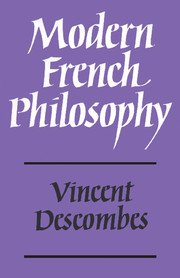Book contents
- Frontmatter
- Contents
- Foreword by Alan Montefiore
- Note on abbreviations and translation
- Introduction: Philosophy in France
- 1 The humanisation of nothingness (Kojève)
- 2 The human origin of truth (Merleau-Ponty)
- 3 Semiology
- 4 The critique of history (Foucault, Althusser)
- 5 Difference (Derrida, Deleuze)
- 6 The end of time (Deleuze, Klossowski, Lyotard)
- Index
3 - Semiology
Published online by Cambridge University Press: 05 June 2012
- Frontmatter
- Contents
- Foreword by Alan Montefiore
- Note on abbreviations and translation
- Introduction: Philosophy in France
- 1 The humanisation of nothingness (Kojève)
- 2 The human origin of truth (Merleau-Ponty)
- 3 Semiology
- 4 The critique of history (Foucault, Althusser)
- 5 Difference (Derrida, Deleuze)
- 6 The end of time (Deleuze, Klossowski, Lyotard)
- Index
Summary
The Intellectual Scene in 1960
The ambition of French phenomenology was to have a dialectical philosophy of history, supported by a phenomenology of the body and of expression. The generation active after 1960, however, condemned dialectics as an illusion, and rejected the phenomenological approach to language. The opposition between the prevailing post-war doctrine and what was soon to acquire for the public the name of structuralism appeared to be – or would have sought to be – total.
The dialectic was the promised land of the little existential tribe of 1950. The greatest criticism that could be levelled against a person was that his thinking was not sufficiently dialectical. After 1960, the dialectic continued to be at the centre of discussion, but it had moved into the dock. It had come to be seen as the most insidious form of the ‘logic of identity’ which in its turn was held to be the supreme philosophical illusion. Here the philosophers of the structuralist era strike a Bergsonian note. What they call the ‘logic of identity’ is that form of thought which cannot represent the other to itself without reducing it to the same, and thereby subordinating difference to identity. The logic of identity is countered with a ‘thinking based upon difference’. The effects of reading Heidegger are discernible in this change of course, and in the accompanying renewal of interest in Nietzsche.
- Type
- Chapter
- Information
- Modern French Philosophy , pp. 75 - 109Publisher: Cambridge University PressPrint publication year: 1981

